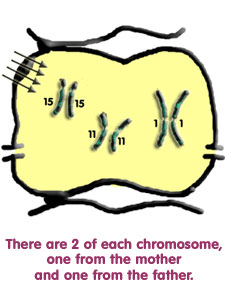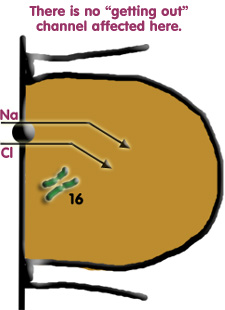|
|
Recently,
in our little group, a good deal of discussion has taken place with regard
to the relationship of Bartter’s Syndrome to Gitelman’s Syndrome.
Gitelman’s has been called a division or variation of Bartter’s and Bartter’s
has been described similarly in its relationship to Gitelman’s.
They are genetically quite different but unfortunately have one thing
in common and that is the loss of salt – NaCl. This
loss, of course, leads to other electrolyte losses. The chromosomes involved
are shown below.
(But please note: they are not really lying loose in the cells, but are inside the nuclei!) |
|
|
|
Bartter’s may result from a defect in one of several chromosomes. Look back to page 4 and note that this syndrome commonly is caused by the malfunction of either the transporter or the channel that recycles potassium or the chloride channel. Each of these is programmed by a different gene on a different chromosome. For the animated drawing, go to page 6 to view normal functioning. |
 |
|
The gene for the transporter is on chromosome 15, for the potassium channel on chromosome 11 and for the chloride channel on chromosome 1. (There is another gene on chromosome 1 where a rare defect causes Bartter's syndrome accompanied by congenital deafness.) If even one of these defects is present the whole transporting system breaks down and Bartter’s syndrome results. |
||
|
|
||
|
|
Gitelman’s is due to a defect on chromosome 16. This affects the transporter that takes sodium and chloride into cells in the distal tubule. A source of confusion lies in the fact that it has been stated that there are many different types of Gitelman’s. In general, what is meant is that many different mistakes or variations occur in the DNA that leads to the formation of the transporter. The end result is the same, a defective transporter. Similarly, mistakes may occur in any of the Bartter’s chromosomes. |
 |
|
Using these drawings to illustrate Gitelman’s we note the defect to occur distally. But it is important to note that the defect described in Bartter's does not occur in Gitelman’s. The transporter and channels affected by Bartter’s are present and working in Gitelman’s but you might say that they don’t have much salt to work on!!! Even so prostaglandins do not always rise because other factors induce renin increase. |
||
| |
Note that in Bartter’s the tubular defect found in Gitelman’s also does not occur. Still, the amount of salt pouring down from above is far too much for the distal system to handle. Similarly, in Gitelman’s the defect found in Bartter’s does not occur. Although a good deal is known about how salt is treated normally in the body, especially by the renin-angiotensin-aldosterone system (RAAS), no good explanation exists as to why magnesium is often lost when different defects occur. The RAAS is concerned with things like sodium, potassium and chloride, all of which have the valency of 1. Where this system crosses paths with calcium and magnesium both of which have a valency of 2 is not understood although some theories have been put forward. |


